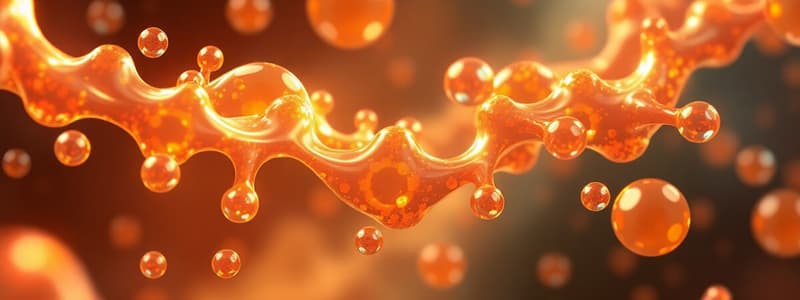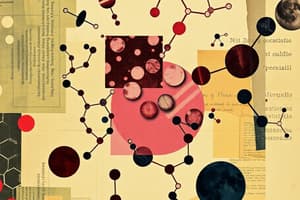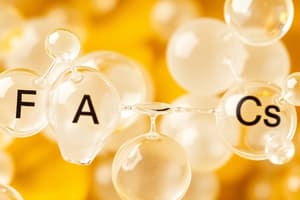Podcast
Questions and Answers
Which of the following characteristics is unique to lipids compared to carbohydrates and proteins?
Which of the following characteristics is unique to lipids compared to carbohydrates and proteins?
- High energy value
- Water insolubility (correct)
- Presence of carbon, hydrogen, and oxygen
- High carbon content
What is the primary structural composition of fats and oils?
What is the primary structural composition of fats and oils?
- Fatty acids and glycerol (correct)
- Nucleotides linked by phosphodiester bonds
- Amino acids linked by peptide bonds
- Monosaccharides linked by glycosidic bonds
What critical role does bile play in the digestion of lipids?
What critical role does bile play in the digestion of lipids?
- Emulsifying fats to increase the surface area for enzyme action (correct)
- Transporting digested fats into the bloodstream
- Hydrolyzing fatty acids from glycerol
- Neutralizing the acidity of fats
What factor primarily determines whether a lipid is classified as a 'fat' or an 'oil'?
What factor primarily determines whether a lipid is classified as a 'fat' or an 'oil'?
Which of the following is the primary reason farm animal diets include fats?
Which of the following is the primary reason farm animal diets include fats?
What distinguishes saturated fatty acids from unsaturated fatty acids?
What distinguishes saturated fatty acids from unsaturated fatty acids?
In ruminant animals, how does the digestion and absorption of fats differ from that in non-ruminant animals?
In ruminant animals, how does the digestion and absorption of fats differ from that in non-ruminant animals?
Which of the following scenarios describes the purpose of protecting fats in ruminant diets?
Which of the following scenarios describes the purpose of protecting fats in ruminant diets?
What are the potential consequences of including too much fat in an animal's diet?
What are the potential consequences of including too much fat in an animal's diet?
How do omega-3 fatty acids exert a protective effect against atherogenesis in humans?
How do omega-3 fatty acids exert a protective effect against atherogenesis in humans?
Given the abbreviated designation 'C 18:2' for linoleic acid. What does this indicate about the fatty acid's structure?
Given the abbreviated designation 'C 18:2' for linoleic acid. What does this indicate about the fatty acid's structure?
What statement accurately describes the role of microorganisms in the digestion of lipids within the rumen?
What statement accurately describes the role of microorganisms in the digestion of lipids within the rumen?
What occurs following the passage of lipids through the omasum and into the abomasum in ruminant digestion?
What occurs following the passage of lipids through the omasum and into the abomasum in ruminant digestion?
What is a unique characteristic of fatty acids synthesized by rumen microbes?
What is a unique characteristic of fatty acids synthesized by rumen microbes?
What is the purpose of the process that encapsulates small droplets of oils in a thin layer of formaldehyde-treated protein (casein)?
What is the purpose of the process that encapsulates small droplets of oils in a thin layer of formaldehyde-treated protein (casein)?
What is the primary function of pancreatic lipase in lipid digestion?
What is the primary function of pancreatic lipase in lipid digestion?
What is the significance of lacteals in the absorption of lipids?
What is the significance of lacteals in the absorption of lipids?
In the context of animal nutrition, what is the purpose of supplemented fats in the diet?
In the context of animal nutrition, what is the purpose of supplemented fats in the diet?
How does the feeding of unsaturated fat in a protected form affect the body's lipid composition?
How does the feeding of unsaturated fat in a protected form affect the body's lipid composition?
What role do omega-3 fatty acids play in modulating the conversion of arachidonic acid?
What role do omega-3 fatty acids play in modulating the conversion of arachidonic acid?
What is the primary characteristic of 'protected fats' that differentiates them from unprotected fats in animal feed?
What is the primary characteristic of 'protected fats' that differentiates them from unprotected fats in animal feed?
Why does the digestion and absorption of fats differ significantly from that of carbohydrates or proteins?
Why does the digestion and absorption of fats differ significantly from that of carbohydrates or proteins?
In simple-stomached animals, what is the primary site for fat digestion?
In simple-stomached animals, what is the primary site for fat digestion?
Which of the following is TRUE regarding the dietary fat requirements of young animals receiving milk or milk replacer, compared to adult ruminants on dry feed?
Which of the following is TRUE regarding the dietary fat requirements of young animals receiving milk or milk replacer, compared to adult ruminants on dry feed?
Which best describes the role of fish meal or full-fat linseed in animal diets, particularly for laying hens?
Which best describes the role of fish meal or full-fat linseed in animal diets, particularly for laying hens?
Select the BEST option that details what occurs during lipid digestion in ruminants?
Select the BEST option that details what occurs during lipid digestion in ruminants?
After the action of pancreatic lipase occur, in what form are the majority of fats absorbed in simple-stomached animals?
After the action of pancreatic lipase occur, in what form are the majority of fats absorbed in simple-stomached animals?
How are the oils found in plant seeds categorized regarding composition?
How are the oils found in plant seeds categorized regarding composition?
What is the typical range for fat supplement percentage in the diet of adult ruminant animals?
What is the typical range for fat supplement percentage in the diet of adult ruminant animals?
Omega-3 fatty acids are essential for fish. What condition can occur from their deficiency?
Omega-3 fatty acids are essential for fish. What condition can occur from their deficiency?
Which of the following fats is generally considered very bad and known to raise cholesterol and increase the risk of heart disease?
Which of the following fats is generally considered very bad and known to raise cholesterol and increase the risk of heart disease?
Why do fats produce more heat than carbohydrates or proteins, with 1 gram of typical fat yielding about 9.45 Kcal of heat?
Why do fats produce more heat than carbohydrates or proteins, with 1 gram of typical fat yielding about 9.45 Kcal of heat?
Flashcards
What are Lipids?
What are Lipids?
Organic compounds found in plants and animals, extractable by fat solvents.
What are Saponifiable Lipids?
What are Saponifiable Lipids?
Classification of lipids that can be broken down with alkali using saponification
What are Non-Saponifiable Lipids?
What are Non-Saponifiable Lipids?
Classification of lipids that cannot be processed under alkaline hydrolysis or saponification.
What are Fats?
What are Fats?
Signup and view all the flashcards
What are Oils?
What are Oils?
Signup and view all the flashcards
What are Fats and Oils composed of?
What are Fats and Oils composed of?
Signup and view all the flashcards
What are Saturated Fatty Acids?
What are Saturated Fatty Acids?
Signup and view all the flashcards
What are Unsaturated Fatty Acids?
What are Unsaturated Fatty Acids?
Signup and view all the flashcards
What characterizes Fats and Oils?
What characterizes Fats and Oils?
Signup and view all the flashcards
What are Triglycerides?
What are Triglycerides?
Signup and view all the flashcards
What are Galactolipids?
What are Galactolipids?
Signup and view all the flashcards
What is dietary fat?
What is dietary fat?
Signup and view all the flashcards
What are Protected Fats?
What are Protected Fats?
Signup and view all the flashcards
What are Omega-3 Fatty Acids?
What are Omega-3 Fatty Acids?
Signup and view all the flashcards
What is Bile?
What is Bile?
Signup and view all the flashcards
What is Pancreatic Lipase?
What is Pancreatic Lipase?
Signup and view all the flashcards
What are Lacteals?
What are Lacteals?
Signup and view all the flashcards
What happens to lipids in ruminants?
What happens to lipids in ruminants?
Signup and view all the flashcards
Study Notes
- Lipids are organic compounds found in plants and animals.
- Lipids include substances extractable from biological materials with fat solvents
- Lipids are insoluble in water, but soluble in organic solvents such as benzene, ether, chloroform, carbon tetrachloride, and acetone.
Classification of Lipids
- Lipids can be classified as saponifiable (simple and compound) and non-saponifiable lipids.
- Simple lipids include fats and oils, and waxes.
- Compound lipids include phospholipids, sphingolipids, glycolipids, and lipoproteins.
- Non-saponifiable lipids include steroids, prostaglandins, fat-soluble vitamins, and trepenes.
Types of Fat
- Unsaturated fats are considered "good" fats and help lower blood cholesterol.
- Sources of unsaturated fats include fish, nuts, seeds, and oils from plants, avocados, olives, walnuts, and liquid vegetable oils such as soybean, corn, safflower, canola, and sunflower.
- Saturated fats are considered "bad" fats and raise cholesterol.
- Sources of saturated fats include beef, beef fat, veal, lamb, pork, lard, poultry fat, butter, cream, milk, cheeses, and other dairy products made from whole and 2 percent milk.
- Trans fats are considered "very bad" fats, raise cholesterol, and increase the risk of heart disease.
- Sources of trans fats include vegetable shortenings, some margarines, crackers, cookies, and snack foods.
Fats and Oils
- Fats are solid at room temperature (25°C), while oils are liquid at the same temperature.
- The difference of physical state is related to the degree of unsaturation of the constituent fatty acids.
- Lipids from animal sources are usually solids (fats), while oils are generally of plant origin.
- In animal nutrition, both fats and oils are generally referred to as fats.
- Fats and oils are composed of fatty acids "of varying lengths and structures" plus one molecule of glycerol and are referred to as mono-, di-, or triglycerides, depending on the number of fatty acids present.
- Fatty acids consist of chains of carbon atoms ranging from 2-24 or more in length, with a carboxyl group on the end.
- If all available positions on carbon atoms are taken up with hydrogen, the fatty acid is referred to as saturated.
- If one or more double bonds are present, the fatty acid is unsaturated.
- Fats and oils are characterized by their high energy value; like carbohydrates, fats contain the elements C, H, and O, but they are relatively much higher in C and H.
- A gram of typical fat yields about 9.45 Kcal of heat when completely combusted, compared with about 4.15 Kcal for a typical carbohydrate.
- Oils found in plant seeds are generally triglycerides, while in forages, a high percentage of the lipids are diglycerides with a molecule of galactose attached to a glycerol molecule "Galactolipids".
- Branched-chain fatty acids and those with an odd number of carbon atoms are often produced by microorganisms.
- In ruminants, body fats may contain substantial amounts of such fatty acids.
- C 2:0 corresponds to acetic acid, "C 2" meaning that there are two carbon atoms and "0" means that no double bonds are present.
- Some examples of saturated fatty acids are acetic (C 2:0), propionic (C 3:0), butyric (C 4:0), caproic (C 6:0), myristic (C 14:0), palmitic (C 16:0), stearic (C 18:0), arachidic (C 20:0), and lignoceric (C 24:0).
- Some examples of unsaturated fatty acids listed are palmitoleic (C 16:1), oleic (C 18:1), linoleic (C 18:2), linolenic (C 18:3), and arachidonic (C 20:4).
- Every practical diet for farm animals, particularly poultry, contains a small amount of fats.
- Fats are necessary as a vehicle for transport and absorption of fat-soluble vitamins and also as a source of essential fatty acids for increasing energy concentration of the diets.
- Examples of fats used in animal diets are tallow, soybean oil, and byproducts of edible oil refining.
- Fat supplementation in the diet - Poultry: 5-10%; Adult ruminant: 3-5% ("more in dairy cattle, 6-8%"); Non-ruminant: 10-15%.
- Too much fat in the ration can reduce feed intake, increase the chances of scouring, and render calcium and magnesium insoluble (insoluble soaps), leading to them being passed out in feces.
- Young animals receiving a high level of milk or milk replacer in their diet will get 25-40% fat in their diet on a dry matter basis, which is a desirable level of fat intake for animals in this age.
- Ruminants on dry feed are less tolerant of high fat levels than are monogastrics and should not receive more than 6-8% fat.
- Adverse effects of high lipid intake (above 10%) in ruminants include a reduction in rumen microbe activity and retarded fermentation of carbohydrates, which can be overcome by feeding "protected fats".
Protected Fats
- Protecting fats involves encapsulating small droplets of oils in a thin layer of formaldehyde-treated protein (casein).
- The droplets avoid attack by microorganisms during passage through the rumen.
- The fat is released by the acidity of the abomasum and thus becomes available for digestion and absorption from the small intestine, similar to non-ruminants.
- Rumen-active oil kills rumen bacteria, reduces fiber digestion, and produces trans fatty acids - milk fat depression.
- These negative effects on fibre digestion can be reduced using rumen-protected fat supplements.
- These supplements avoid milk fat-reducing trans fat in rumen.
- Major groups of rumen-protected fats are saturated fatty acids like hydrogenated/fractionated fats, which have high melting points.
- Calcium salts of palm oil, like that of Megalac, are also widely used and proven.
- Feeding unsaturated fat in protected form results in a rise in the degree of unsaturation of plasma lipids and the milk and body fat composition.
- The use of rumen-protected unsaturated fats is promoted in the context of prevention of human heart diseases and atherosclerosis.
- The connection between human diseases and saturated fat is considered controversial.
- It is noted that the shelf-life of unsaturated milk is poor.
Omega-3 and Omega-6 Fatty Acids
- Recent evidence shows a protective effect of fish oils against atherogenic processes in humans, due to their high content of polyunsaturated fatty acids (Omega-3 FAs).
- Examples of omega-3 fatty acids are linolenic acid (C 18:3), ecosapentaenoic acid (EPA) (C 20:5), and docosahexaenoic acid (DHA) (C 22:6).
- Marine fish have a higher content of omega-3 fatty acids than freshwater fish.
- The content varies with the species, season of the year, water temperature, and the food eaten by the fish.
- Omega-3 fatty acids lower total serum lipids and cholesterol and also modulate the conversion of arachidonic acid to prostaglandins.
- Feeding laying hens with two specific feed ingredients can produce omega-3 fatty acid-enriched eggs, often called "designer eggs".
- Increasing omega-3 products can be achieved by using fish meal or full-fat linseed, with linseed being one of the richest plant sources of omega-3 fatty acids, such as linolenic acid, which are acceptable in taste to consumers and have value in healthful diets for avoiding coronary heart diseases.
- Omega-3 fatty acids are dietary essentials for fish with its deficiency leading to poor growth, liver and heart lesions, and a shock syndrome.
- For dogs, omega-3 and omega-6 fatty acids are especially important as essential fatty acids, preventing and treating dermatitis.
Digestion and Absorption of Fats
- Fat digestion and absorption differ principally from that for carbohydrates or proteins since fats are non-polar and not miscible with water.
- The primary object of lipid digestion is to arrange lipids in a water-miscible form that can be absorbed through the microvilli of the small intestine.
- In simple-stomached animals, fat digestion primarily occurs in the small intestine.
- Digestion occurs through the action of bile, which emulsifies the fat.
- Production of oil-in-water emulsion increases its surface area.
- Further aid is provided by pancreatic lipase, an enzyme hydrolyzing fatty acids from the glycerol molecule.
- The contribution of gastric lipase is considered to be quite low.
- Some diglycerides are absorbed but the majority of absorption is as monoglycerides and fatty acids.
- Longer-chain fatty acids are absorbed by lacteals into the lymph system, which then enters the blood stream just before the vena cava vein enters the heart.
- In ruminants, yields of propionic acid as a result of a rumen process are absorbed like material from carbohydrate fermentation.
- Unlike monogastrics, this process doesn't primarily result in monoglycerides, but rather yields glycerol and free FAs.
- Bacteria and protozoa (rumen microbes) also synthesize FAs for the lipids of their own cells containing branched chains and odd numbers.
- These lipids, containing branched chains and odd numbers, pass from rumen through omasum to the abomasum "where bact. and protozoa disintegrate, releasing their lipids".
- All products then pass to the small intestine, "where any triglyceride is hydrolyzed by pancreatic lipase to monoglyceride and FAs, as in nonruminant" then are absorbed similarly to non-ruminants.
- After, resynthesis of triglycerides and phospholipids occurs in the intestinal mucosa.
Studying That Suits You
Use AI to generate personalized quizzes and flashcards to suit your learning preferences.




